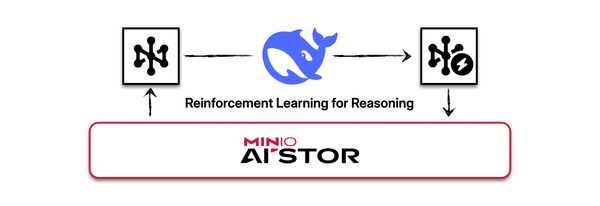
Relationships matter, especially in your data. Explore graph analytics without moving data using PuppyGraph, Apache Iceberg, and MinIO AIStor. Quickly set up a cloud-native graph analytics stack that uncovers hidden patterns directly from your data lakehouse.
Read more

Apache Iceberg is significantly transforming modern data lakes. Its introduction to object storage platforms has been celebrated for delivering ACID transactions, strong schema evolution, and warehouse-like reliability to data lake architectures. The Iceberg Catalog API standard is crucial to this transformation, as it ensures that various tools can consistently discover tables and execute atomic transactions once a compliant catalog service
Read more

We were talking with a well-respected industry analyst the other day and he challenged us to articulate why Kubernetes is so important to Object Storage. It got us thinking that this was a topic worthy of our time, and yours.
Why Kubernetes Demands More Than Just Stateless Apps
At the most basic level, the value of Kubernetes lies in its
Read more

Legacy systems drain budgets, slow innovation, and block AI progress. This article shows how phased modernization cuts costs, boosts performance, and builds a future-ready data foundation without disruption. Inaction is the real risk.
Read more

While still in its infancy, it’s no secret that enterprise AI adoption is shaking up the entire technology landscape.
Five years ago, CIOs were under immense pressure to figure out their cloud strategy and the answer was, put simply, migrate everything to the public cloud (AWS, Azure, GCP). Now, CIOs are under even more pressure to figure out their
Read more

This is the story of how an enterprise cloud content platform architected one of the largest and most resilient SmartStore deployments in production using MinIO AIStor and Splunk SmartStore.
One of the world’s largest content platforms faced a serious scaling issue. They were ingesting multiple terabytes of observability data per day, and that footprint was growing by multiple petabytes
Read more

How a global manufacturer is cutting inspection labor by 10x with anomaly detection and edge-native object storage
Overview
On factory floors around the world, visual inspection remains one of the most labor-intensive and error-prone steps in the manufacturing process. At one global consumer goods manufacturer, this challenge is being redefined with AI at the edge. By replacing manual spot checks
Read more

AIStor S3 Express is a high-performance object storage API designed for demanding data lakehouse workloads. Benchmarks show it outperforming AWS S3 Express on LIST operations and large object GETs.
Read more

The Model Context Protocol (MCP) from Anthropic represents a unique approach to Agentic AI tooling as compared to many of its competitors. Rather than building a framework (software that calls your code) or a library (software that your code can call), MCP focuses on the protocol needed for different parts of an agent to communicate with each other. This has
Read more

Built a portable Java data pipeline using MinIO's AIStor and Kafka that scales from Mac to Kubernetes. Containerized stack (Kafka, AIStor, Prometheus, Grafana) processes millions of events, preserving raw data for analysis while delivering real-time dashboard summaries.
Read more

In data engineering, open standards are foundational for building interoperable, evolvable, and non-proprietary systems. Apache Iceberg, an open table format, is a prime example. Along with compute, Iceberg brings structure and reliability to data lakes. When coupled with high-performance object storage like MinIO AIStor, Iceberg unlocks new avenues for creating next-generation, high-performance, cost-effective, and scalable architectures.
However, this powerful table
Read more

This post first appeared on The New Stack on April 18th, 2025.
Get a comprehensive summary of the major compute, networking, storage and partnership announcements from NVIDIA’s biggest event of the year.
If you follow the tech news, you have read a lot about NVIDIA and its graphics processing units (GPUs). However, it would be incorrect to conclude that
Read more

Apache Iceberg has significantly reshaped how organizations manage and interact with massive structured analytical datasets inside object storage. It brings database-like reliability and powerful features such as ACID transactions, schema evolution, and time travel. Although these features are commonly emphasized, the Iceberg Catalog API is what makes these tables accessible.
The Iceberg Catalog API is a centralized interface for managing
Read more

Creating a framework for high-performance, cloud-native object storage is mission-critical in the modern enterprise. Take a look at The Buyer’s Guide to Software Defined #ObjectStorage to understand the key capabilities.
Read more

In the previous blog posts of this series, we discussed the user-level and admin-level functions of the Model Context Protocol (MCP) server for MinIO AIStor. In the first blog, we learned how to review the bucket’s contents, analyze objects, and tag them for future processing. In the second blog, we also learned how to use admin commands and get
Read more

In the previous blog of this series, we discussed the basic user-level functions of the Model Context Protocol (MCP) server for MinIO AIStor. We learned how to review a bucket’s contents, analyze objects, and tag them for future processing using human-language commands and simply chatting with the cluster via an LLM such as Anthropic Claude.
In this blog, we’
Read more

GenAI is entering the agentic phase, with software agents collaborating with humans and other agents to reason and achieve complex goals. Agents are already demonstrating incredible intelligence and are very helpful with question answering, but as with humans, they need the ability to discover and access software applications and other services to actually perform useful work. The creators of such
Read more

Want real-time analytics and blazing-fast performance? Learn how to build a high-speed, on-prem pipeline with Materialize and MinIO AIStor—faster than S3, high thoughput, and built for AI. Includes a full tutorial to get you up and running locally.
Read more

Tl;dr: We train a small LLM to become good at reasoning with reinforcement learning (similar to the process that led to Deepseek R1) all against AIStor AIHub, an on-premises model repository. Based on the great GRPO demo by will brown.
Motivation:
A growing requirement for teams is the need for an organized, secure, "single source of truth"
Read more




















